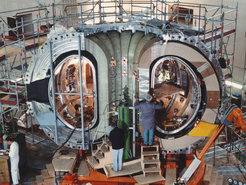Magnet coils
Most fusion devices nowadays feature normally conducting magnet coils made of copper. The 2.5 metres high main-field coils of ASDEX Upgrade, for example, are composed of copper rails the width of a hand. For cooling purposes they are provided with bores to allow the passage of cooling water. The windings are insulated with fibreglass bands and moulded in synthetic resin, to connect them together and give the coil the necessary mechanical strength. The coil can thus withstand the strong forces exerted between the coils after the coil current is switched on.

A future fusion power plant will operate with superconducting coils. Unlike copper coils, superconducting coils — cooled to low temperatures — use no energy after being switched on; the coil current flows with almost no losses.
The niobium-titanium superconductor envisaged for the ITER test reactor is to generate a magnetic field of 13 tesla (on the coil, i.e. 5.7 tesla on the magnetic field axis). The superconducting strands are embedded in copper wires and enclosed in a blanket of high-grade steel. Inside the blanket liquid helium circulates and cools the coils to 4.5 Kelvin, close to absolute zero. Model coils have been used to test this superconductor and demonstrate the essential production sequence, from the individual superconducting strands to the complete coil. In the meantime, production is underway; the first main-field coils were completed by companies in Japan and Europe.
